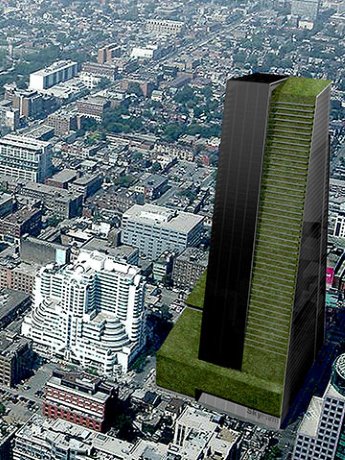Gordon Graff once envisioned a 59-storey agricultural high-rise in downtown Toronto’s entertainment district. With 2.7 million square feet of floor space for fruits, vegetables and poultry, SkyFarm stood to feed tens of thousands of people and match 1,000 rural acres in production.
Graff, a student in the Master of Architecture program at the University of Waterloo when he developed the prototype in 2007, never realized his vision, at least at the site he’d proposed. The Toronto International Film Festival is grazing there, instead.
Now an intern architect with DIALOG in Toronto, Graff spoke at the Urban Agriculture Summit in Toronto in August and conceded that the high-rise urban farm “is a concept whose time has not yet come.”
Still, with the global population expected to increase by 2 million by 2050 and conventional agricultural production significantly stretched, Graff sees a future for the vertical farm.
“Its emergence would be a great thing for human society,” he said.
While conventional crops are vulnerable to drought and pests and reliant on chemicals, indoor food production can be controlled in terms of temperature, light, humidity, irrigation and nutrient levels.
“In a contained environment, pests, pathogens and weeds have a much harder time infiltrating and destroying crops,” Graff said.
Conventional crops require enormous volumes of water, and transpired water in an indoor operation could be captured and circulated back into the system. And, vertical orientation maximizes land use.
Graff said his proposal was inspired by a desire to test the notion of vertical farming.
“The idea that grabbed me was a building that could produce food on the upper floors and in its cellars, and market it on the ground floor,” he explained.
Through design efforts, Graff said, he discovered constraints. For example, not all areas enjoy direct sunlight.
“In the discussion about vertical farming, there’s still a lot of talk about using sunlight. But most of my work is with artificial light because I don’t think it’s likely we’ll find a way to use sunlight effectively.”
With indoor plants needing artificial light much of the time, vertical farm buildings are likely to have a high energy load.
There’s also biowaste from crops and livestock such as poultry.
“Cities already have a problem with providing a stable electricity grid and dealing with urban waste, so we don’t want a vertical farm that contributes to these two problems,” Graff said.
However, anaerobic digesters can capture waste methane, a natural gas that could be used to produce energy,” Graff said.
Even the liquid slurry extruded by the anaerobic digesters could be supplied to rural farms as fertilizer, flipping the relationship between rural production and urban consumption.
Graff’s dream for an agricultural high-rise may be realized in stages. Paul Lightfoot, CEO of BrightFarms, told a separate session that his company finances, builds and operates greenhouses atop supermarkets and other buildings in the U.S.
BrightFarms is designing a 930-square-metre rooftop greenhouse that will sit atop an affordable housing complex in the Bronx and supply produce to people living in what’s considered a food desert — a neighbourhood lacking grocery stores but abundant in cheap, unhealthy fast-food.
Lightfoot said local grocery store owners are realizing food grown locally stands to offer a competitive advantage.
“We sign contracts where supermarkets commit to buying varieties of produce at fixed prices for a long term,” Lightfoot said.
“This guarantees revenue, and we’re able to attract the capital to build these farms and hire local farmers.”
There are construction challenges, though. Rooftop greenhouses need proper load-bearing walls. These can be incorporated into the blueprints for new buildings. Older buildings are sometimes suitable, but modern supermarkets often lack sufficient supports, Lightfoot said, recommending a structural analysis before adapting existing structures.
BrightFarms has established rooftop greenhouses in communities as far flung as St. Louis and rural Buck’s County, Pennsylvania, but Lightfoot said they’re generally a hard sell.
“Developers don’t see themselves as farm developers, and they aren’t.”



Recent Comments
comments for this post are closed